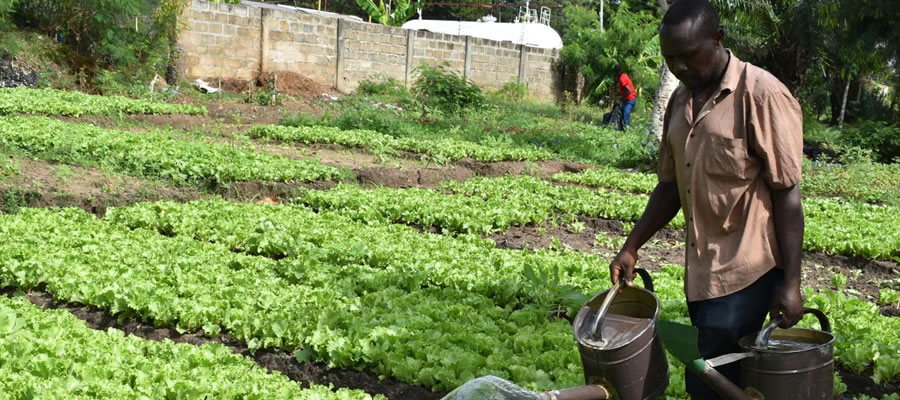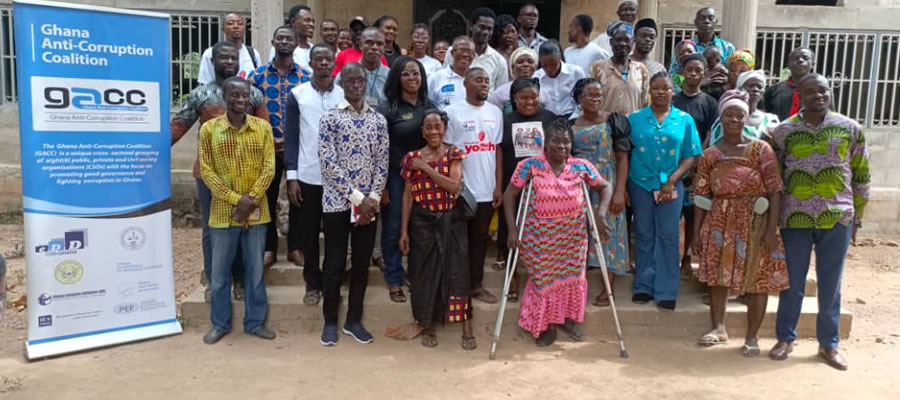

Economy of the District
Household Income and Expenditure
The average annual household income is GH¢1,136.00 with expenditure of GH¢1,305. Also there is an average remittance of approximately GH¢170.00. Considering the District annual average household expenditure as against the income, one can say that the people in the district have to rely on relatives and friends for remittances and other sources of income like loans in order to improve their lot.
The expenditure pattern indicates that households spend 52.78% of their total expenditure on food. On the other hand, since the bulk of the income is spent on food, people do little savings for capital accumulations by the Rural Banks to able them grant loans. Expenditure on clothing is the second item on the expenditure pattern where 8.25% is spent.
This is high spending on clothing (8.25%) as a result of Christmas and other festivals celebrated in the country, which force parents to clothes for their children. Also people have desire in buying new cloths for funerals and other occasions which they see it as in elastic to them. There is the need therefore to encourage people to develop the habit of savings and investment.
The analysis also revealed that expenditure on education and medical care are 3.32% and 3.18% respectively. This low expenditure can be attributed to the introduction of Capitation Grant, School Feeding programme, and the National Health Insurance Scheme in the country of which the district is beneficiary.
On the other hand, though 52.78% of the people in the district income are spent on food, it comprises of farm products (85%) and the rest is physical cash. This is because 80.2% percent of the people in the district are peasant farmers and consume major percentage of the food they produce. This has been quantified into cash which add up to 52.78% of their expenditure on food.
Also, there is the need to reduce expenditure on funeral donations which is 5.52%. More so, the critical analysis on energy indicates that, people spend more on kerosene than on electricity. This implies that, when most of the communities are connected to the national electricity grid, average expenditure on energy will reduce to appreciable amount.
Inter and intra-trade
The district has five major periodic markets which are inter-linked with access roads. These are shown in table 5.9.In terms of importance and size,Badu market comes first(Tuesday) followed by Nsawkaw market (Wednesday).Brodi has Thursday as its market day followed by Seikwa and Brohani having Friday as their market day. In terms of distance, Brodi is the furthers (33.8km) from Nsawkaw the district capital. This is followed by Badu (30km), and the closest to the district capital, Seikwa has 27.5km.
Commodity Flow
The study of flow of the agricultural goods was in and out of the study region was done to establish the linkages that exist among these regions. From the table it can clearly be seen that the flow of maize in and out of the study area is higher than the other commodities with 26.5% imported and 26.7% exported. Yam is as well the second highest commodity that flow in and out of the market centres with 19.1% imported and 19.1% exported follow by Pepper with 15.1 imported and 15.2% exported to the rest are Cassava with 14.6% imported and 14.8% exported ,Beans with 12.8% imported and 13.0 exported, and Groundnut 11.3% imported and 11.6% exported.
As much as Six Hundred and Fifty Seven Thousand and Three Hundred and Sixty Five (GH¢ 657,365.00) were exported to the other regions while Five Hundred and Seventy-Seven Thousand (GH¢ 577,000.000) worth of goods were imported making the region a net exporter of agricultural goods value Eighty Thousand, Three Hundred and Sixty Five (80,365.00).
The District mainly inter-trade with Banda, Jaman North, Kintampo South and Sunyani West Districts Assemblies and Wenchi and Berkum Municipal Assemblies
This therefore reveals that the region mainly exports only agricultural commodities to its neighboring regions. This confirms the agrarian nature of the area. One can conclude that the district cannot boast of any existing industries that manufacture both finished and agricultural inputs and hence makes the district net importer of industrial and agricultural inputs.
Financial Institutions
National Investment Bank, Baduman Rural Bank, Nkoranman Rural Bank, BACCSOD and Berekum Teachers’ Credit Union are the financial institutions operating in the District. These institutions give support in terms of credit facilities to most of the micro and small- scale enterprises to help them grow and expand their businesses. They also accept deposits and cash withdrawals.
Occupation
Skilled agricultural forestry and fishery workers comprise the major occupation in the district; accounting for 80.8 percent of the district’s employed population. This means about eight out of every ten persons 15 years and older of the employed population are into agriculture, forestry or fishery.
Some proportions of the employed persons are engaged as service and sales workers (6.2%) and Craft and related trades workers (5.6%). Professional workers constitute only 2.6 percent of the employed population 15 years and above.
The rest of the employed population is managerial, technicians and associate professionals and many other workers as shown in Table 1.22.
Date Created : 11/20/2017 5:56:16 AM












 facebook
facebook
 twitter
twitter
 Youtube
Youtube
 +233 593 831 280
+233 593 831 280 0800 430 430
0800 430 430 GPS: GE-231-4383
GPS: GE-231-4383 info@ghanadistricts.com
info@ghanadistricts.com Box GP1044, Accra, Ghana
Box GP1044, Accra, Ghana